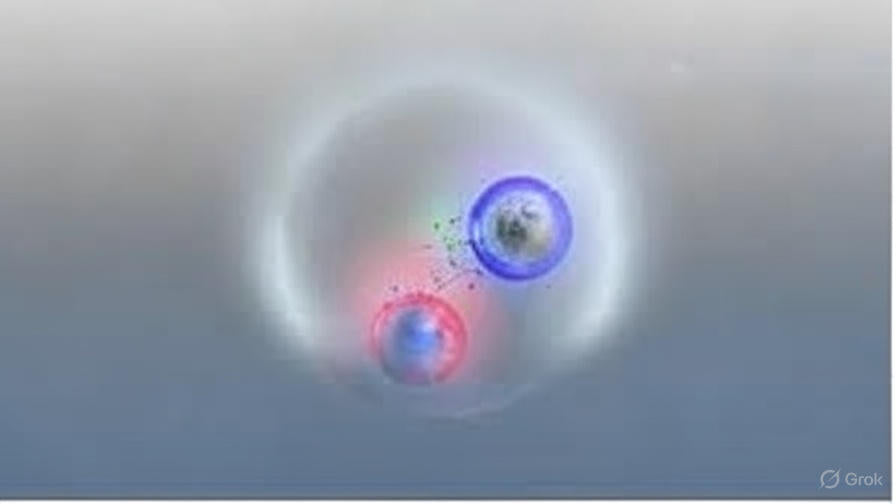Top Quark Discovery at LHC Opens New Window into the Early Universe
Introduction
On October 2, 2025, a post by @ShiningScience announced a major scientific milestone: researchers at CERN’s Large Hadron Collider (LHC) successfully observed top quark pairs in lead-lead (Pb-Pb) collisions for the first time.
This breakthrough confirms long-standing predictions in quantum chromodynamics (QCD) and introduces a powerful new way to study the quark-gluon plasma (QGP) — a primordial state of matter that existed just microseconds after the Big Bang.
The announcement has sparked worldwide excitement among physicists and science enthusiasts because it connects laboratory research directly to the conditions of the infant universe.
In a breakthrough, researchers at CERN's Large Hadron Collider (LHC) have successfully observed top quark pairs produced during lead-lead (Pb-Pb) collisions—marking the first time these heaviest elementary particles have been detected in such high-energy nuclear interactions.… pic.twitter.com/XEIQseyGzB
— Shining Science (@ShiningScience) October 2, 2025
About the Discovery
- Where: CERN’s LHC — the world’s largest and most powerful particle accelerator.
- When: Based on LHC Run 2 data at 5.02 TeV per nucleon-pair energy.
- What: First-ever observation of top quark pair production in heavy-ion collisions.
- Significance: Confirms theories predicting that top quarks can be produced and studied even in extreme nuclear environments.
The Science Explained
Top quarks are the heaviest known elementary particles.
- They decay almost instantly — in about 10⁻²⁵ seconds.
- The QGP created in Pb-Pb collisions lasts longer — around 10⁻²³ seconds.
Because of this timing difference, the decay products of top quarks interact with the QGP, effectively serving as “time markers” for physicists trying to study the plasma’s short-lived properties.
In their analysis, the ATLAS collaboration focused on the dilepton decay channel:
- Top quarks decay into bottom quarks and W bosons.
- W bosons further decay into electrons or muons and neutrinos.
By identifying these decay patterns amid the intense environment of heavy-ion collisions, the team achieved a statistical significance of 5.0 standard deviations, confirming the discovery.
Although the measured production rate has a 35% uncertainty due to limited data, upcoming runs of the LHC are expected to improve precision dramatically.
Why It Matters
The result isn’t just another particle-physics milestone — it’s a window into the universe’s first microseconds.
Studying how top quark decay products lose energy or scatter as they move through the QGP:
- Reveals the temperature, density, and structure of the plasma.
- Helps refine our understanding of the strong nuclear force (QCD).
- Informs models of cosmic events like neutron star mergers and other extreme environments.
By recreating these ancient conditions in a laboratory, scientists can investigate how matter as we know it emerged from the fiery beginnings of the cosmos.
Impact on Future Research
This discovery sets the stage for:
- Exploring new decay channels (like semi-leptonic modes) to examine the QGP in even greater detail.
- Advancing heavy-ion collision techniques with better bottom-quark tagging and higher collision rates.
- Testing theories beyond the Standard Model, as more precise data could reveal unexpected deviations or anomalies.
The LHC’s Run 3 and future upgrades will make it possible to observe top quarks in greater numbers, potentially uncovering insights that go beyond our current physics framework.
Public Reaction and Discussion
The original tweet received:
- 182 likes, 32 reposts, 4 quotes, 10 replies, 32 bookmarks, and 4,779 views.
While most replies were speculative or off-topic (including conspiracy and religious commentary), the core message stands as a science-driven breakthrough that excites the global research community.
FAQs
- Q1: What is a top quark?
- A fundamental particle — the heaviest in the Standard Model — that decays too quickly to form composite particles.
- Q2: What is the quark-gluon plasma (QGP)?
- A hot, dense state of free quarks and gluons that existed moments after the Big Bang, recreated in heavy-ion collisions at the LHC.
- Q3: Why is observing top quarks in Pb-Pb collisions significant?
- It proves that these heavy particles can serve as unique probes of the QGP’s short-lived properties.
- Q4: How does this help us understand the early universe?
- By studying how top quark decay products interact with QGP, scientists can reconstruct conditions similar to those that existed microseconds after the Big Bang.
- Q5: What’s next for this line of research?
- Future LHC runs aim to gather more data, refine measurements, and test for signs of new physics beyond the Standard Model.
Conclusion
The observation of top quark pairs in heavy-ion collisions marks a historic moment for particle physics. It validates long-standing theories, expands the LHC’s scientific reach, and provides a unique experimental window into the universe’s formative stages.
This achievement highlights how human curiosity, advanced technology, and global collaboration can unravel mysteries once thought beyond reach.
Opinion
This discovery illustrates a profound paradox: humanity uses one of its most advanced machines — the Large Hadron Collider — to study events that occurred naturally long before galaxies or life existed.
By colliding heavy ions at extreme energies, we momentarily recreate the conditions of the Big Bang, gaining knowledge about the very fabric of reality.
Yet, the answers raise new questions:
- If the early universe’s building blocks behaved differently in such a plasma, could similar processes occur in other cosmic environments today?
- Will further study of top quark interactions reveal subtle flaws in the Standard Model, hinting at deeper laws of nature?
- How far can we go in experimentally simulating the past without crossing ethical or technical limits?
Rather than closing debates, the discovery challenges both scientists and society to think more deeply about the nature of matter, the origins of the cosmos, and our place in understanding it.
This is not just a milestone — it’s an invitation to keep questioning the universe itself.


0 comments